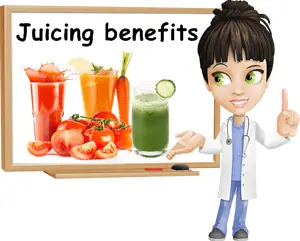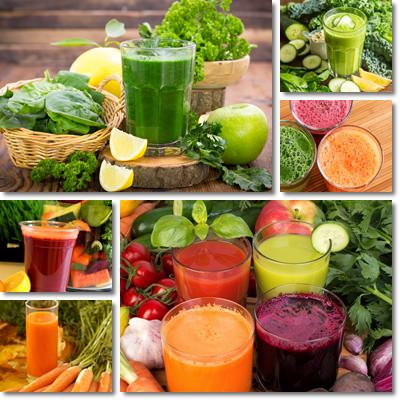Juicing fruits and vegetables can have a wonderfully beneficial impact on our overall health, provided it is done correctly.
Fruit and vegetable juices are easy on the stomach, aiding digestion naturally. They provide a more than generous supply of essential vitamins and minerals in an unaltered form as well as important antioxidants. Complementing our diet with a variety of natural juices improves intestinal motility and has an overall detoxifying effect.
What is juicing?
Juicing is the mechanical process of extracting the juice from raw fruits and vegetables. It is best done with the help of a professional juicing machine and represents a fun, easy and delicious way to improve our diet and up our nutrient intake to more health-significant levels. If done correctly, juicing can prove a great ally for good health as well as complement, and I stress complement, an already balanced and varied diet.

What is the difference between juicing and blending fruits and vegetables?
As mentioned above, juicing is the process through which juice is extracted from fruits and vegetables, leaving behind the skin and a juiceless pulp. Blending refers to mashing or crushing fruits and vegetables until you obtain a soft, thick, yet drinkable mush.
While blending can be done with any regular blending machine, juicing requires a juicing machine, especially made for extracting all the liquid from fruits and vegetables. While it may be costly, its cost per use and durability make it worth every penny.
Why is juicing good for you? (10 Benefits of Juicing)
It is important to remember that juicing does not substitute a healthy, varied and balanced diet. Juicing should merely complement an already healthy and balanced diet and supply whatever nutrients might be missing. So is juicing healthy? Yes. And here are the 10 best reasons to try it:
1) Improves digestion
While juices do not incorporate the dietary fiber from fruit and vegetable skins, they are easier to digest because they are basically already pre-digested.
The juice form of fruits and vegetables does not have to be broken down like regular, solid foods. This means that the nutrients in the juice are absorbed faster and easier. This also explains why anyone of a juice fast or juice-only cleanse is always hungry.
2) Ups vitamin and mineral intake
This is because the fruits and vegetables we juice are raw and thus preserve all of their nutrients. Cooking heat has a devastating effect on the nutrients in food. Only 15 minutes of cooking heat can destroy up to 30 or 40% of most vitamins. Juicing raw fruits and vegetables allows us to enjoy a maximum of nutrients from the fruits and vegetables we eat.
However, remember that juices are best consumed fresh and should only be kept for a maximum of 24 hours refrigerated in an airtight container so they do not oxidize and lose nutritional value.
Moreover, fat-soluble vitamins such as vitamins A, D, E and K require us to consume fats as well in order to absorb them, which is another argument in favor of fruit and vegetable juices being a complementary addition to one’s diet.

3) Keeps us hydrated
The majority of fruits and vegetables are about 80% water. So enjoying even a medium glass of juice can supply us with much needed nutrients as well as liquids. Keeping hydrated helps ease digestion, relieve constipation, raise blood plasma levels, preventing fainting as well as contributes to cellular function.
4) Promotes weight loss
Juices are full of nutrients, yet low in calories and supply sufficient amounts of water to keep us hydrated. Increasing our water intake alone can help us drop a few pounds a year without doing much else. Moreover, by enjoying a glass of green juice instead of a chocolate bar for a midday snack, we lower our calorie intake for the day and slowly work our way towards a slimmer figure.
As a general rule, when juicing, we should keep to 80% vegetables and 20% fruits. This way our juices remain low in calories, but high in antioxidants and essential nutrients.
5) Relieves constipation
The high intake of water from juiced fruits and vegetables really helps put things into motion, regulating intestinal transit and bowel movements. This contributes to a more regular expulsion of toxins from the body, especially the colon, ensuring better digestive health and an even better mindset, as well as all the detoxification our body needs.
6) Increases our antioxidant intake
Each color of each fruit or vegetable we juice is indicative of at least one important antioxidant compound. The orange color in carrots, pumpkin, mango and cantaloupe indicates the presence of carotenoids, blueberries, plums, mirabelles and mulberries are rich in anthocyanins, beets have betaine, while leafy greens contain both chlorophyll and carotenoids.
And considering that we add at least 2-3 different vegetables and a fruit to our juice, we get a lot more antioxidant than we would when consuming our vegetables and fruits in solid form.
Antioxidants help hunt down harmful molecules called free radicals, reduce cellular damage and inflammation levels and allow our body to heal and revert to its normal, healthy self.
7) More energy
Consuming juiced fruits and vegetables ensures we get a generous intake of vitamins and minerals which give us energy to go up and about. The whole point of eating in general is to absorb essential nutrients and produce energy. Juicing our fruits and vegetables allows us to absorb those nutrients faster and make use of them easier, hence the energy boost we get after a generous glass of spinach, celery, carrot and apple juice.
8) Contributes to cardiovascular health
Raw fruits and vegetables in particular are rich in heart-friendly compounds, notably potassium and magnesium, as well as nitrate (in lettuce, cabbage, spinach, arugula or beets). Potassium helps regulate blood pressure by balancing sodium levels and regulating body fluids.
Magnesium contributes to the health of the heart muscle. Nitrates are converted into nitrite which reacts to the oxygen in water and becomes nitric oxide. Nitric oxide is a vasodilator which helps lower high blood pressure.
9) Adds variety
Having a varied diet is important for staying healthy. By eating all kinds of different foods, preferably in their natural form (not just tomato sauce and peppers on pizza), we not only stand a higher chance of getting most of the nutrients we need for the day, but we also risk less because we are not exposed to the same toxic pesticides, insecticides or preservatives again and again as it might happen if we only ate one type of fruit or vegetable. And, believe it or not, unless we cultivate our own produce, we have no real guarantee that what we purchase is actually pesticide-free.
10) Great for a healthy mind
Cooking can be a major stress relief for some, while others may find it overwhelming. But washing some fruits and vegetables, peeling, chopping and juicing them can still be relaxing for those of you who enjoying kitchen time and for those of you who are afraid of the pot of boiling water on the stove. Moreover, taking in all of those colors, different scents and experimenting with texture and taste is a great time out for an overworked mind.
Juicing does have its disadvantages. Juicers are fairly costly and, unless we grow our own produce, we have to keep an eye on discounts, maybe get coupons and special offers so we do not pay our hearts out for organic produce.
The process itself is somewhat time-consuming because of how easily juices oxidize and lose their properties. Some people may even find the taste of mostly vegetable-based juices unappealing. So why juice, you ask? To compliment a healthy diet and enjoy some benefits and overall better health, I’d say.
Conclusion
Modern meals are centered on heartier foods, often leaving out fruits and even vegetables. As a result, very few people eat their minimum servings of fruits and vegetables each day, leaving them at a loss for both essential nutrients and important antioxidants. The solution? Juicing. But done correctly, by maintaining the 80% vegetable-20% fruit ratio and continuing to enjoy a healthy, balanced and varied diet.
